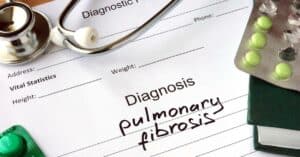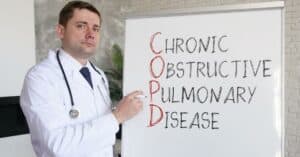People living with chronic obstructive pulmonary disease (COPD) understand the importance of following their COPD treatment plan. Some doctors recommend additional lifestyle modifications to help their patients maximize their COPD treatment plan.
Here are five easy steps to help you gain the most out of your COPD treatment plan.
How Do I Get Started to Maximize My COPD Treatment Plan?
One of the most important steps you can take is to quit smoking if you’re currently smoking. While stopping smoking is challenging, there are quit smoking helplines, medications and support groups available to help you quit for good.
Also, it’s essential to talk with your doctor about your COPD treatment plan and any lifestyle modifications before trying them. Your doctor can guide you as you work to maximize your COPD treatment plan.
5. Practice Relaxation Tips
Often, living with COPD causes stress. Constantly working extra hard just to breathe can increase fatigue and frustration. Many people feel worried and anxious about their condition, which is normal.
People tend to practice relaxation techniques to manage the stress and anxiety caused by living with COPD. Making relaxation and stress management part of your daily routine will help you reduce the symptoms associated with COPD and stress.
Read More: Traditional Vs. Natural COPD Treatment
Set Aside Quiet Time
Living with COPD brings a lot of added stress. That stress can weigh on you. Even things that bring you happiness can feel like a chore when you feel stressed. So, set aside time every day to sit quietly.
During your quiet time, leave your phone and any other distracting items in another room so that you can focus only on you. Reflect on anything that comes up.
Many people enjoy writing their thoughts in a journal. Others prefer to sit quietly and meditate. As you’re sitting quietly, repeat phrases like “I feel peace” or “I am safe.”
For some people, complete silence helps them relax. For others, having soft instrumental music playing in the background calms them down better. You can try both to see which better suits your needs. Setting aside quiet time promotes stress reduction and eases anxiety.
Get Some Rest
COPD causes fatigue and can make getting a restful night’s sleep difficult. Balance your activities with rest. Avoid caffeine after 5 p.m. During the day, stop and take a break when you feel like you’re starting to wear out.
Sticking to a regular sleep schedule helps your body develop a circadian rhythm. Your body learns when you wake up and go to bed naturally. An example of a good sleep schedule is going to bed at 9 PM/ 10 PM and waking up at 5 AM/ 6 AM.
Leave any laptops, tablets, cell phones and work out of bed.
Staying on schedule may help you gain more restful sleep at night and feel less fatigue throughout the day.
Laugh It Up

When you laugh, stress hormones (cortisol) lower and mood-boosting hormones (endorphins) increase. Laughter helps relieve tension and stress, all while boosting your mood. Watch a funny movie, read a hilarious book or call your friend that knows how to make you smile.
4. Try Breathing Techniques
Specific breathing exercises can help people stay more relaxed during COPD symptoms, such as shortness of breath. Two standard techniques include pursed lips breathing and diaphragmatic breathing.
Pursed Lips Breathing
The pursed lips breathing technique helps to address shortness of breath and helps to reduce how hard you have to work on breathing. In addition, it helps promote relaxation. The key is to focus on breathing in and out slowly.
Here’s how to do pursed lips breathing:
- Relax your neck and shoulders.
- Breathe in slowly through your nose while you count to two (keeping your mouth closed).
- Purse your lips as if you’re going to whistle or give a kiss.
- Breathe out slowly and steadily through your mouth while you count to four.
Diaphragmatic Breathing
Diaphragmatic breathing or belly breathing helps people with COPD retrain the diaphragm to work better. This helps them breathe more efficiently. Here’s how to perform diaphragmatic breathing:
- Lie on your back with your knees bent or resting on a pillow.
- Place one hand on your upper chest and one hand on your belly.
- Inhale slowly through your nose.
- As you breathe in, focus on feeling the hand on your belly rise and the hand on your chest remaining as still as possible.
- Exhale slowly through your mouth like you would in pursed lips breathing.
- As you breathe out, focus on feeling the hand on your belly go down first.
- Repeat as you are able.
When it comes to trying breathing exercises, it’s important to talk with your doctor or respiratory therapist before trying the breathing exercises.
3. Start a Gentle Exercise Program
It may seem counterproductive but exercise is important for people with COPD. Staying as active a possible helps your muscles remain strong and helps you have better endurance. You don’t have to head to the gym to exercise either.
Simple, gentle exercises are a great way to build your stamina and strength. You can try walking short distances at first and then build-up as you feel stronger. Walking is low impact but is an excellent and easier form of exercise.
As you progress, you will be able to walk longer distances. Some people like to count their steps to monitor their progress. Consider buying a pedometer, which will count your steps for you.
You don’t need weights at home to strengthen your muscles. Go to your cupboard and find two cans of vegetables. With one can of vegetables in each hand, you can lift the canned goods like you would for weights.
Before you start or change your exercise routine, make sure you talk with your doctor.
2. Eat a Healthy COPD Diet
Having a healthy COPD-diet is important. Certain foods can aggravate COPD symptoms. Many people find it helpful to avoid eating foods that worsen their symptoms.
Foods that may worsen symptoms include cured meats and cold cuts, cruciferous vegetables (broccoli and cauliflower), carbonated beverages (sodas) and fried foods.
After avoiding certain foods, you might wonder what to eat now. Protein is one of the most important nutrients your body needs. In fact, protein helps your body work more efficiently, so it can heal itself, build muscle and create other body chemicals.
Try to mix your protein sources. For example, eat lean meats like baked chicken and shrimp. Also, mix in nuts, eggs and Greek yogurt to your diet.
Many people with COPD are vitamin D deficient. While drinking milk does not cause extra mucus to develop, it does cause the existing mucus to become thicker.
Instead of dairy milk, try a non-dairy, vitamin D fortified milk such as almond or soy milk. Other vitamin D-rich foods include yogurt, fish, tofu, whole grain cereals and some shellfish.
Water is essential for the body to function well. However, many people don’t drink enough water. Drinking water hydrates your body, so your body can remove waste and provide nutrients to its cells, organs and tissues better.
In fact, drinking water can help to thin mucus. Thinner mucus is easier to expel. In addition, improved water intake has been linked to better sleep quality, reduced headaches, reduced phlegm and increased energy. Instead of grabbing that soda, give water a try.
1. Create an Action Plan
When you have a COPD action plan in place, it helps ease anxiety and reduce worry. You’ll know what to do when your COPD is well-controlled and when you need to seek immediate medical help.
Work with your doctor to develop a COPD action plan to address your specific symptoms and needs. Every plan is individualized to best suit the patient’s needs. The plan may change over time as your COPD progresses.
While each action plan will outline specific steps for your symptoms, below is an example plan that you can share with your doctor.
COPD Action Plan Example:
Green Zone:
Symptoms are well-controlled. You take your medications daily as prescribed by your doctor. You keep all scheduled appointments and follow your COPD treatment plan.
Yellow Zone:
COPD symptoms have increased or changed. You may feel more breathless than usual or have increased coughing and mucus. These changes could be a sign of a COPD flare-up.
Your action plan will outline what to do if you feel an increase in COPD symptoms. It will have how to take rescue inhalers, when to use oxygen and how to use your breathing exercises. Also, the plan will discuss when to call your doctor.
Red Zone:
Sudden or severe COPD symptoms like very bad shortness of breath, chills, fever, confusion, chest pain or coughing up blood could be a medical emergency.
You action plan should outline what to do in case of an emergency. Have your contacts listed out in your plan. Your doctor will include how to use your oxygen. Call 911 and get help right away.
Again, the above COPD action plan is an example. You and your doctor will work together to make the best COPD action plan for you.

Christine Kingsley, APRN is the Health and Wellness Director at the Lung Institute where she focuses on providing helpful online resources for people looking for information on various lung diseases, breathing exercises, and healthy lifestyle choices. She advocates for holistic care that involves working with your doctor to explore all options including traditional and alternative care while focusing on diet and exercise as proactive measures.









